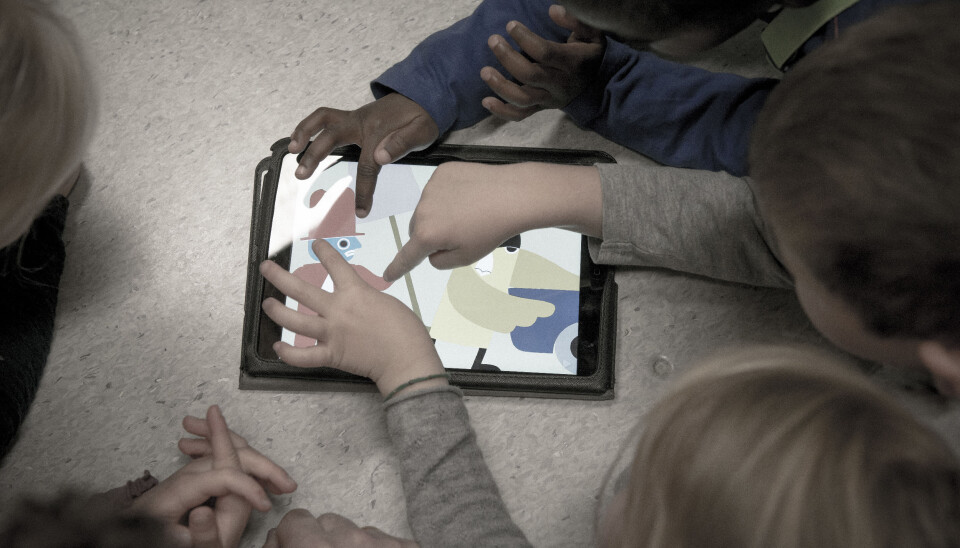This article was produced and financed by University of Stavanger - read more

Children and kindergarten teachers use digital picture books differently
Although the digital book apps are a lot of fun to use, they also present major challenges in a kindergarten setting.
Their focus is not on the same thing. The kindergarten teacher’s goal is to explore and discuss the story and the pictures with the children.
The children may be more interested in what they can do by touching the screen. They hear sounds and see animations when they tap so-called hotspots — the points on the screen that trigger action.
The interactive possibilities pull the children in one direction, while the kindergarten teacher works to maintain the children's attention and have discussions with them.

A tug-of-war is present here – the hotspots on the one hand, the kindergarten teacher and the conversation about the story on the other.
Want to make things happen
The technical term for this conflict is didactic dissonance. The term was first used by researchers Vigdis Vangsnes and Nils Tore Økland in 2015 and deals with challenges and tensions in digital learning situations when kindergarten teachers and children have conflicting roles and expectations.
The children are experienced users of tablet computers. They know they can make things happen by touching the screen, and this is exactly what the touchscreen is designed for. The picture book apps offer many opportunities. Kindergartners can activate sounds, animations and games by touching the screen, and that makes them curious. What features can we discover? What can we make happen? The children are encouraged to play and explore.
“A traditional hardback also has its intended working mode: such as leafing through the pages to 'discover what happens’ in the story. Hardback books also have their limitations”, says Trude Hoel, associate professor at the Norwegian Reading Centre at the University of Stavanger.
“We have learnt these working modes, and we use them when we read together with children. Now we need to equip ourselves to use new types of reading, with new media”, adds Margrethe Jernes, associate professor at the Department of Early Childhood Education at the University of Stavanger.
Filmed reading sessions
In their research, Hoel and Jernes have examined the challenges associated with using interactive picture book apps. They have collected the experiences of kindergarten teachers who have filmed reading sessions with kindergartners. During the study, kindergarten teachers read two books in both print and digital versions to their groups of children and shared their experiences regarding the apps after the first and second readings.
“When we read a hardback, we assimilate the text in a different way”, said one of six kindergarten teachers who participated in the study.
“When the children are encouraged to touch the screen and discover the sounds and effects through the picture book app, I think that the story fades into the background somewhat and that they don't get the whole point.”
Technology requires careful consideration
The researchers believe that the use of technology in kindergarten must be carefully considered. Modes of reading must be designed based on the goals set by the kindergarten and the media they adopt in the specific situation.
Previous research has indicated that digital media can lead the children to become more deeply involved. The question is what kind of involvement. Do children become more conscious about the content of the book? Does their awareness reinforce the dialogue about the story? Prior research shows that children’s engagement is more a bodily involvement, fingers touching the screen, not necessarily involvement in the narrative.
“In fact, the interactive possibilities can sometimes divert interest away from the narrative itself”, Hoel says.
The interactive possibilities pull the children in one direction, while the kindergarten teacher pulls them in another direction and tries to keep the children's attention and engage them in dialogue.

The screen attracts attention
One of the kindergarten teachers in the study said: “I found it difficult to use the book with the children. The pictures are very cluttered. The children were more interested in what is going on in the pictures and want to tap the screen. The text is lost.”
When the kindergarten teacher wants to get the children engaged in dialogue, it can be challenging to compete with the hotspots and enticing effects on the tablet. Moreover, once the children have been allowed to touch the screen, the kindergarten teacher feels that the plan for the reading session needs to be changed, she reports. There's no longer time to talk about the story and the illustrations. It's all about maintaining some control over the situation and the digital medium, often accompanied by a feeling of resignation and that the reading session has been unsuccessful. This is what researchers call didactic dissonance, and it happens to the best teachers.

The two researchers are aware of the fact that the digital picture book is still quite new and that kindergarten teachers lack experience and knowledge in using it. It is no longer a case of being able to think about content and reading; we now have to relate to what the digital picture book wants to accomplish. What are the aims of the app? What are the possibilities? What are the limitations? How can the digital book best be used? The children tend to want to touch the screen all the time. They all want to make things happen in the picture book app. All the kindergarten teacher can do is maybe repeat the rule ‘one person at a time’ in the hope that she can make the groups sharing the tablet more manageable.
“The study certainly doesn't find that hardback books are ‘best’. It's not a question of winning or losing. It's about knowing what you want as a kindergarten teacher and understanding what the medium wants to accomplish, about considering what you can do and how it can be organised”, Jernes points out.
Preparation means more control
One of the kindergarten teachers talks about her preparations for the second reading of the digital picture book:
“(I) figured out all the animations, what could be tapped on the screen and when it was best to do so. I think I became more focused on everything that could be done and when it would be best to do it than I was on the actual text of the book. I had made note of some exciting words [...], the openings in the text naturally had to come before we "turned" to the next page, since I had decided to let the app read the book out loud.”
Hoel and Jernes saw that something happened from the first to the second reading. The kindergarten teachers relied on their experiences from the first reading when they planned the second reading session. They were open and honest with the researchers about having been blindsided by the children's overenthusiasm during their first encounter with the tablet. The kindergarten teachers also said they wanted to have more control over the activity the next time a digital picture book was to be used in a reading session.
The second time, the kindergarten teachers planned and made provisions for the children to take turns so that the reading session would not become, to the same degree as before, a free-for-all to touch the screen. Agreements were made: "one page each" or "one time each". The kindergarten teachers themselves believed that this resulted in better control and a more peaceful reading session. The preparations created a calmer and more stable situation for both the children and the kindergarten teacher.
The researchers want to help kindergarten teachers become aware of the pedagogical struggle between their teaching aims and the aims of the apps and to be able to recognize these, instead of feeling powerless.
“Kindergarten teachers who gain knowledge and experience in using digital media in their educational work will be able to face the challenges presented by interactive picture books with professional competence and assurance”, Jernes concludes.

































